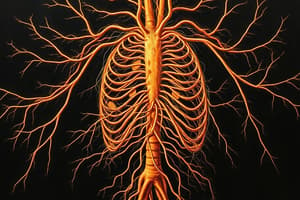Podcast
Questions and Answers
The cerebrum is responsible for coordinating muscle movements and maintaining balance.
The cerebrum is responsible for coordinating muscle movements and maintaining balance.
False (B)
The temporal lobe is responsible for visual processing.
The temporal lobe is responsible for visual processing.
False (B)
The cerebellum is divided into four lobes.
The cerebellum is divided into four lobes.
False (B)
The brainstem connects the cerebrum to the spinal cord.
The brainstem connects the cerebrum to the spinal cord.
The peripheral nervous system is composed of the brain and spinal cord.
The peripheral nervous system is composed of the brain and spinal cord.
The somatic nervous system is responsible for controlling involuntary body functions.
The somatic nervous system is responsible for controlling involuntary body functions.
The autonomic nervous system consists of the sympathetic nervous system and the parasitic nervous system.
The autonomic nervous system consists of the sympathetic nervous system and the parasitic nervous system.
The parasympathetic nervous system prepares the body for action.
The parasympathetic nervous system prepares the body for action.
The nervous system is not involved in regulating and coordinating body functions.
The nervous system is not involved in regulating and coordinating body functions.
The autonomic nervous system controls basic life-sustaining functions such as breathing and heart rate.
The autonomic nervous system controls basic life-sustaining functions such as breathing and heart rate.
Flashcards are hidden until you start studying
Study Notes
Human Nervous System: An Overview
The human nervous system is a complex and intricate network of cells, fibers, and structures that is responsible for controlling and coordinating the body's functions. It is made up of two main parts: the central nervous system (CNS) and the peripheral nervous system (PNS). The CNS consists of the brain and spinal cord, while the PNS includes nerves that transmit signals between the CNS and the rest of the body.
Central Nervous System (CNS)
The human brain is the most complex organ in the human body, consisting of approximately 100 billion neurons connected by synapses. It is divided into three main parts: the cerebrum, cerebellum, and brainstem.
Cerebrum
The cerebrum is the largest part of the brain and is responsible for higher cognitive functions such as thinking, learning, and memory. It is divided into four lobes: the frontal lobe (responsible for motor control and cognition), the parietal lobe (responsible for sensory perception and spatial awareness), the temporal lobe (responsible for auditory processing and memory), and the occipital lobe (responsible for visual processing).
Cerebellum
The cerebellum is located at the back of the brain and is responsible for coordinating muscle movements and maintaining balance. It also plays a role in learning and memory.
Brainstem
The brainstem connects the cerebrum and the cerebellum to the spinal cord. It is responsible for controlling basic life-sustaining functions such as breathing, heart rate, and blood pressure.
Peripheral Nervous System (PNS)
The PNS consists of a system of nerves that transmit signals between the CNS and the rest of the body. It is divided into two main parts: the somatic nervous system (SNS) and the autonomic nervous system (ANS).
Somatic Nervous System (SNS)
The SNS controls voluntary movements and sensation. It is responsible for transmitting signals from the brain to muscles and sensory organs.
Autonomic Nervous System (ANS)
The ANS controls involuntary body functions such as digestion, heart rate, and respiration. It is divided into two parts: the sympathetic nervous system (SNS) and the parasympathetic nervous system (PNS). The SNS prepares the body for action, while the PNS helps the body relax and conserve energy.
Functions and Interactions of the Nervous System
The nervous system plays a crucial role in regulating and coordinating the body's functions. It receives information from sensory organs, processes it in the brain, and sends signals to muscles and glands to produce a response. The nervous system also helps maintain homeostasis by monitoring and controlling body temperature, blood pressure, and other internal conditions.
The nervous system is also involved in higher cognitive functions such as learning, memory, and problem-solving. It interacts with other systems in the body, such as the endocrine system, to maintain overall health and well-being.
Studying That Suits You
Use AI to generate personalized quizzes and flashcards to suit your learning preferences.



